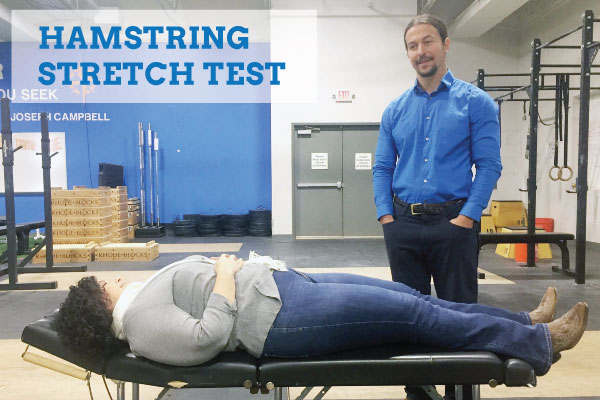
12 Dec Know Your Numbers: The Hamstring Stretch Test
Think you have a hamstring stretch there? The odds are, you don’t.
Yogis and CrossFitters around the world stretch on a daily basis. With the #1 muscle being the hamstrings.
Physical therapists and chiropractors prescribe hamstring stretches for all sorts of pain: low back pain, hip pain, knee pain, and everything in between.
Yet, most people’s hamstring flexibility never increases. Week after week. Month after month. Year after year.
And most people never stop to wonder why?
Here’s a five minute test you can do with a friend to determine if you’re stretching your hamstrings or … something else. And damaging your body in the meantime.
Mobility: Hamstring Stretch Test | Straight Leg Raise (SLR)

The hamstring stretch test is what you can use to determine what you’re stretching when you do any hamstring stretch.
What do you need to Measure this Test?
If you’re going for the simple distinction of “Am I stretching my hamstring or not?”, which I strongly recommend, you will need a table and a smiling friend.
If you want to get the full amount of data from this test, which I DO NOT recommend, you’ll need a table and an inclinometer. This isn’t the exact inclinometer we use, but for $8 and an Amazon Prime membership, you can have it in a day. The reason I don’t recommend it is because there is a large margin of error, even between doctors who have been measuring this a long time.
What is the Hamstring Stretch Test assessing?
The mobility of your hamstring muscles, sciatic nerve, and spinal cord through your spinal column.
What Specific Problems are relevant here?
Any low back problem, especially disc conditions and spinal stenosis, piriformis syndrome, hamstring strains, hamstring tendinosis, and some structural hip pathologies can show up with the hamstring stretch test.
What You Need to Know
This test can be complex to interpret. If you have multiple issues, especially anything involving the low back, I recommend you seek out a musculoskeletal specialist. Don’t mess around with an angry disc. Here, I’m going to let you interpret one small part of this test.
How to Test:
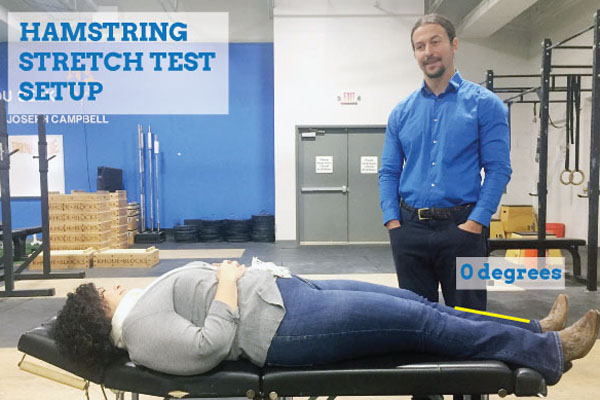
Take your shoes off and lie on your back. Have you friend stand behind your leg and pull your thigh until your knee stays straight. It’s important that your leg stays straight. If at any point your knee bends, have your friend back up the range of motion until your knee is straight.
Your friend should lift your leg until one of the following happen:
- she feels heavy resistance against her shoulder, as if your muscles are winding tight
- your opposite thigh comes off the table
- you feel intense stretching or pain.
The below picture is an example of a false range of motion because Sue Ann’s right thigh has come away from the table.
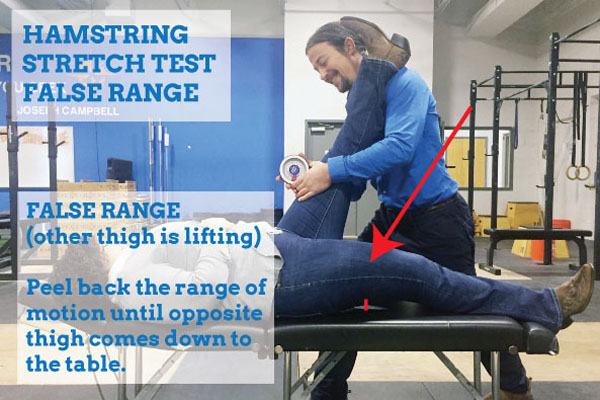
At the moment any of those things happen, your friend should back up the range of motion to your complete end range.
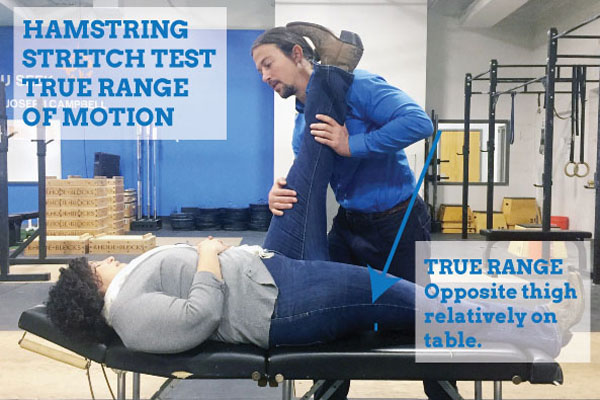
Write down:
At this point, both you and your friend should eyeball your leg range of motion. If you have a 3rd friend with an I-phone, have her take a picture. You can then put the picture into the Keynote app on your trusty Apple product and add lines to tell you what the precise range of motion it is.
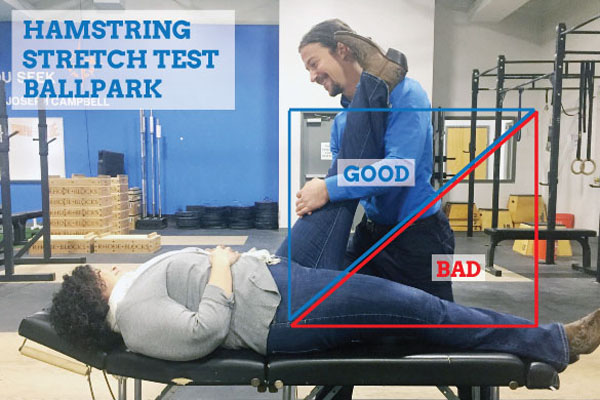
If you don’t have someone to take a picture, is the shin closer to straight up and down (perpendicular to the ground or 90 degrees)? If yes, you have “good” range of motion.
Or is the shin closer to 45 degrees or worse? Then, you have “bad” range of motion.
Take note of the “stretch” you feel. Note:
- the location – point to where you feel it. Is it the low back, butt, hamstring, calves? Or somewhere else?
- the quality – is it a “stretch”, a “sharp pain”, a “lightning-like or numb, tingly feeling” or something else?
- the intensity – is it mild, moderate, or severe?
When that’s all written down, you’re not done yet …
The Most Valuable Info You Should Get From The Hamstring Stretch Test
Have your friend push on the ball of your foot 1″ towards the front of your shin. For the biomechanists in the room, you’re adding ankle dorsiflexion to the movement.
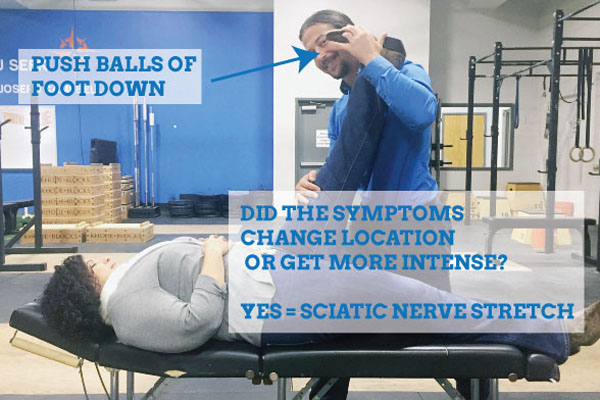
Now, for the big moment.
Does the location, quality, and intesity of the “stretch” stay the same?
If yes, congratulations! You have a real hamstring stretch.
Does the location, quality, and intesity of the “stretch” change, probably getting more intense?
Then, your sciatic nerve is causing you to feel a “stretch,” that you interpret in your brain as a “hamstring stretch”. In reality, your hamstring muscle is contracting to prevent you from letting the sciatic nerve experience any more tension and it’s telling you to stop. If you feel the stretch in your calf, then you are feeling a sciatic nerve stretch. It stretches in your calf because that’s the weakest part of your sciatic nerve.
If your shin was perpendicular to the floor, then you have full range and you can stop reading anything more.
If your shin was anything less than perpendicular, keep reading to find out what to do now.
If your range was restricted, something is going on with your hamstring, usually one of these three things:
- Weakness (least common)
- Myofascial glue called adhesion (more common)
- Turned off by your brain & sciatic nerve entrapment (most common)

Hamstring Weakness (least common)
If the front of your thigh got close to straight up and down (perpendicular to the ground or 90 degrees), you pass the hamstring stretch test.
You may still have hamstring weakness though.
To find out if you have hamstring weakness, check your lunge and have someone record a video of your form from in front of you.
If your knee caves in like mine does (at 1:00), then it’s safe to say your hamstring muscles are weak.
If you have weak hamstrings, strengthen them with hamstring bridges.
To perform, lie on the ground with your feet up on a chair. Your hip, knees, and ankles should be at 90 degree angles. Push your heels down into the chair and lift your butt off the ground about 4″. You can check that distance by putting your fist behind your butt and only going as high as you need to clear your butt. Bring your butt down to the ground, touch and “kiss” the ground, and immediately go into the next rep. It should take you 3 seconds on the way up and another 3 seconds on the way down.
Perform 2 sets of 15 repetitions of hamstring bridges daily. If weakness is truly your problem, in as little as 2 weeks, your lunge should be much better. In a month, it won’t be an issue any longer.
Glued Hamstring (more common)
If the front of your thigh does not get close to straight up and down (far from perpendicular to the ground or less than 90 degrees) and if ankle dorsiflexion did not make your pull/stretch worse in your hamstring, then you most likely have glue, most commonly known as adhesion, in your hamstrings.
Adhesion literally looks and feels like glue within your muscle belly.

There are two ways to remove adhesion in the hamstrings.
- Scissors or a scalpel (through surgery).
- A skilled doctor’s or therapist’s fingers.
A WORD OF CAUTION: If a therapist or doctor wants to use instruments such as Graston Technique on your hamstrings, run out the door. Graston Technique works really well in certain areas of the body. The hamstrings are not one of them. There is a lot of fat under the skin (even for lean individuals) in the back of the thighs that won’t let treatment be effective.
As far as the two strategies to remove adhesion in the hamstrings, feel free to youtube search “hamstring surgery” to visualize why #1 isn’t the ideal option.
When you’re ready to have a skilled doctor work on your hamstrings, go find a provider on Integrative Diagnosis’s (ID) Online Directory. No one gets more education and skill development on removing adhesion than ID doctors.
If your range of motion is close to full (75-90 degrees), you can attempt to stretch for a month with lots of static stretching over a month. If it doesn’t improve, then find an ID Doctor. You don’t want to stretch if you’re closer to the “bad” zone because with 99% certainty, your “hamstring stretch” is sciatic nerve.
Stretching nerves makes nerves angry. Avoid the angry bear and don’t stretch nerves.
Hamstring Turned Off by Your Brain (most common)
If the front of your thigh does not get close to straight up and down (far from perpendicular to the ground or less than 90 degrees) and if ankle dorsiflexion does make your pull/stretch worse in your hamstring or symptoms pop up in a new place, then your sciatic nerve is responsible for shutting your hamstrings down.
The hamstring stretch test, alone, cannot help us determine the location your sciatic nerve is stuck at: your hamstring, piriformis, or low back.
If you have symptoms in your low back, butt, or hamstrings, it’s safe to assume that the location of stuckness is probably that location.
Regardless, you need to find a provider on Integrative Diagnosis’s (ID) Online Directory to resolve this issue further.
A 2nd WORD OF CAUTION: Do not stretch a hamstring that is stopped by sciatic nerve tension. This problem will get worse on its own. It will get worse faster if you stretch it.
Stretching nerves makes nerves really unhappy. Make your nerves happy by finding out the real problem.
Advanced Testing for the Hamstring Stretch Test
Read this section only if you want to know just how bad the health of your “hamstrings” or sciatic nerves are.
You’ll need an inclinometer. Have your friend put it on the top/front area of your shin.
Note below that Sue Ann’s leg is not quite parallel to the ground. For simplicity, accept this angle as 0 degreees to get a ballpark for how tight you are.

Pass
The closer your thigh is to perpendicular, the better your range of motion.
Passing is 90 degrees. If your knee doesn’t cave in during the lunge, your hamstrings are strong enough for you to live life without worrying about pain, injury, or degeneration such as arthritis.
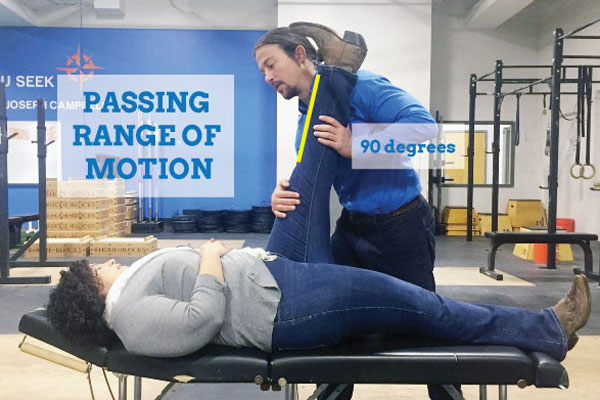
Fail – Low Risk
A fail with low risk of injury is any range of motion between 75 and 90 degrees.
Fail – Moderate Risk
A fail with moderate risk of injury is any range of motion between 65 and 75 degrees.
Fail – High Risk
A fail with high risk of injury is any range of motion less than 65 degrees.
Get Your Mindset Right So You Never Have to Re-read This
The story that physical therapists, orthopedic doctors, and the rest of conventional medicine tells you about stretching hamstrings is a good one.
People keep stretching despite evidence that flexibility doesn’t ever get any better.
What I’ve attempted to do here is to bring your attention to how important the right data in a very simple test can do to help you focus on your tightness or annoying injuries.
The hamstring stretch test tells you what the potential problem is:
- hamstring weakness
- glued hamstring
- hamstring turned off by the brain
How bad it is:
- Straight up and down (perpendicular or 90 degreres) = A grade
- 65 – 75 degrees = B – C grade
- < 65 degrees = Fail
And what to do about it:
- strengthen with hamstring bridges.
- stretch.
- find an ID Doctor.
Your mindset, focused on the right problem, is the only fast and permanent path towards making your hamstring flexibility better. Keep shotgunning and shooting in the dark … and you’re destined to re-read this article again 12 months from now.
What do I do now?
If you want to, you can stretch your hamstrings for a month, then re-measure this test to see if it gets better. If your range of motion improves, keep stretching. Wash, rinse, repeat. If your range of motion doesn’t get better, seek out a qualified musculoskeletal provider to figure out why.
One month. No longer.
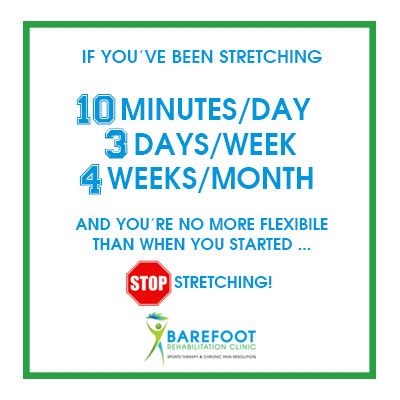
A failure to stop stretching a muscle that never improves range of motion guarantees that you eventually will spend a lot of time stretching, only to have your flexibility move in the opposite direction. Getting tighter and tighter over time.
I’d stop that if I were you.
As always, feel free to reach out if you want input on your what is working or isn’t for your hamstring flexibility. We love to help people, even when they aren’t patients in our office.
 What did you learn with the hamstring stretch test? Is your range of motion full? Is your “hamstring stretch” an actual hamstring stretch or the sciatic nerve screaming out? Please share in the comments below.
What did you learn with the hamstring stretch test? Is your range of motion full? Is your “hamstring stretch” an actual hamstring stretch or the sciatic nerve screaming out? Please share in the comments below.

Yolanda burden
Posted at 02:33h, 15 AprilI’ve been stretching for 2 months . Almost nightly ( Missed 3 days ) my pain started in the neck from severe whiplash . It’s moved lower and lower . It would be easier to ask me what I haven’t tried . 9 years ! 9 years I’ve tried over and over only to always end in so much more pain. The stretching had made me a bit more flexible. But I feel worse ! My legs .. worse ! I’ve noticed that I cannot walk or stand half as long as I did before I started stretching . I have nothing physically wrong in MRI scans . Nothing . I cannot locate the main source of the pain .. I’m now on disability and I’ve am trying desperately to get my life back . Any suggestions would be so appreciated!
Dr. Chris
Posted at 19:10h, 17 AprilHi Yolanda, so sorry to hear this. Yeah, we recommend on all our social platforms and to all of our patients to STOP stretching.
1. Can you find an integrative diagnosis doctor? This is BY FAR what you need.
2. How’s your diet, sleep, stress, and meditation practice? If bad, you might be a candidate for PERMANENT relief in our 10 week Pain Free and Happy program. If you want to see if you are DEFINITELY a candidate, email rich at barefootrehab dot com and tell me you’d like to talk to see.
here for you <3
Cindy Meredith
Posted at 22:25h, 08 AprilI appreciate you posting the “Hamstring stretch test” so much! I now know for certain that my issue is with my sciatic nerve. Knowledge is power. Thank you so so. so much!
Dr. Chris
Posted at 13:55h, 10 AprilYup, you’re a smart cookie. Most people have this sciatic nerve issue so kudos to you for figuring it out